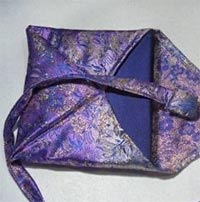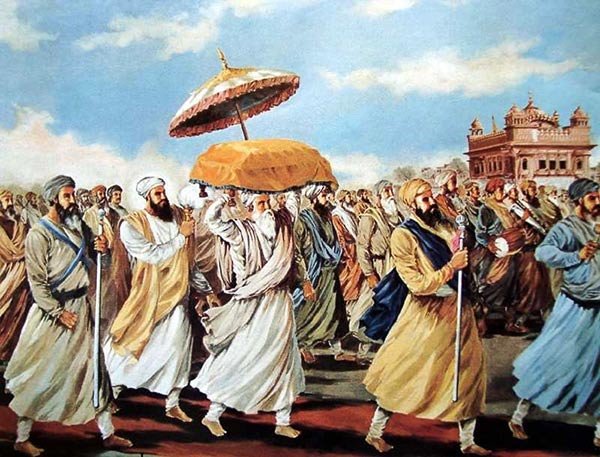There is a certain respect that the printed word of the Shabad Guru is treated with.
Senchi/Pothi/Gutka/Nitnem These are different collections of Banis. Gutkas and Nitnems are smaller prints that one can conveniently keep to read daily prayers and Banis. Pothis are compilations of Banis and writings of the Guru's. Senchis are prints of the Guru Granth Sahib in several volumes. These are used for translations and study of the Guru's word.
These are different collections of Banis. Gutkas and Nitnems are smaller prints that one can conveniently keep to read daily prayers and Banis. Pothis are compilations of Banis and writings of the Guru's. Senchis are prints of the Guru Granth Sahib in several volumes. These are used for translations and study of the Guru's word.
It is recommended to keep these volumes in it's own place like a clean shelf or table with nothing else on it. It is also recommended to put them on a surface that is higher than other objects in the room. It is customary to cover them with a cloth (small rumalla). It is ok to stack prints of the Shabad Guru with each other, but please don't stack them with other books, or put on a bookshelf. It is traditional to touch our foreheads to the volume before and after reading from it.
Please do not place any of these prints on the ground.
We consider the Shabad Guru to be the highest vibration in existence. In the mind of a Sikh it is higher than anything else could be. To represent that regard physically, we put it higher than other objects.
 Please wash your hands before handling or reading
Please wash your hands before handling or reading
Handling the prints with dirty hands will wear out the pages and make the edges brown. Even if you think your hands are clean there is always a little sweat or dirt that may be on there. It is very important to wash your hands right before handling the Shabad Guru.
Please cover your head while reading
Reading of the Shabad Guru is a spiritual experience. Out of respect for anything or any act that is spiritual, we cover our 10th gate (7th chakra), which is on the top of the head. This is why Sikhs wear turbans. If you do not wear a turban normally, please cover your head with a cloth out of respect for this highest energy and vibration.
The reason for these protocols of respect is to grow a sense of reverence inside of ourselves. When we approach something with reverence we are then able to get the blessings of that thing. The Shabad Guru can actually liberate our souls. It is a LIVING GURU. The Siri Guru Granth Sahib exists to give a clear and practical way of liberation to all of humanity. So, something that has this kind of spiritual power needs to be activated. These protocols are a physical respect that reflects the deep reverence we have in our hearts.
F.A.Q.
How do I get a Rumalla? Rumallas are easy to find in India. In other countries it may be difficult to find, but you can search online and find some options. However you can use any nice cloth as a Rumalla, it doesn't have to be from India. You can go to a cloth store, and get a square piece of silk (for example), and have it hemmed on the edges. You can use a saropa (orange cotton scarf). If you don't have a saropa, you can get a Khalsa Orange cloth from gosikh.com.
Rumallas are easy to find in India. In other countries it may be difficult to find, but you can search online and find some options. However you can use any nice cloth as a Rumalla, it doesn't have to be from India. You can go to a cloth store, and get a square piece of silk (for example), and have it hemmed on the edges. You can use a saropa (orange cotton scarf). If you don't have a saropa, you can get a Khalsa Orange cloth from gosikh.com.
What kind of head-cover should I wear?
Any cloth that will cover the top of your head. You can wear a scarf, bandana, chunni, or even a hat. You can purchase head-covers (patkas) here gosikh.com. Natural fibers like cotton are best.
Should we give the same respect to the translated volumes as we do to the Siri Guru Granth Sahib savrup?
According to the SGPC rehet if the Siri Guru Granth Sahib has a translation and/or is split into separate volumes, it is not considered a savrup of the Siri Guru Granth Sahib. It is then afforded the respect of Nitnems and the like.
Should I have the translated volumes only in their own room ie-Gurdwara?
These volumes can be treated like a Savrup of the Siri Guru Granth Sahib if desired. They can be kept on a palki, with a chandoa, and chouri sahib as well. However you can also keep them in a room in your house as long as you follow the above mentioned protocols.
Siri Guru Granth Sahib
The Siri Guru Granth Sahib in one volume, is considered to be the actual body of the lineage of Living Guru's from Guru Nanak. The Siri Guru Granth Sahib is to be carried on one's head. It sits in it's own seat (palki) with pillows to cushion its binding, and nice clothes (Rumallas) dressing it. There should be a canopy (chandoa) above it, to signify it's royalty. When available there is a sevadar waving a chouri (fly-whisk) over it. This is the Guru of the Sikhs, and the center of worship in a Sikh Temple (Gurdwara). Everyone who enters bows and gives a donation to the Siri Guru. The Siri Guru is opened in the morning (Prakash), and put to bed at night (Sukhasan). There are more details of how to perform these services, that are not included in this article.

Related Videos
